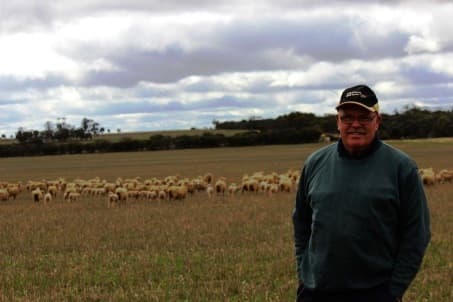Dohne Lambs Get up and Grow
By CAITLYN BURLING | 13 September 2014 | Farm Weekly
“It’s nice to get some away early and get that early cash flow from the peak prices.”
WHEN Barry Harrap drives around his Dohne ewes at lambing time, he still gets surprised at how quickly the lambs get up and grow.
Even though the Koorda farmer made the switch from Merinos to pure Dohne eight years ago, the hardiness of the ewes and lambs continues to confirm he made the right decision.
“They are so deceiving sometimes, because the lambs are so small when they come out, they are like pups,” Barry said.
“But then you look at them a week later and it’s astonishing how much they have grown.
“I think the shearers like them for their plain body but not so much for the weight in them.
“They’re heavy buggers.”
Having the ability to run sheep that grow quickly and stack on the kilograms in marginal areas such as Koorda has meant Barry and wife Bev can maximise the productivity of their 3700 owned and leased hectares.
The Harrap’s flock of 800 Dohne breeders and 300 Dohne maiden ewes were much more drought-tolerant and hardy than Merinos, with the added benefit of still producing a saleable wool clip.
Barry said the only noticeable changes in fleece production were less grease and a slight drop in micron, but he believed the Dohne fleece outperformed the Merino when it came to price per/kg clean.
Nowadays, the Harrap’s wool clip averages 19 micron and is a lot softer to handle than when it was shorn in February or March.
Shearing is over and done with before the lambs started dropping throughout April and May, which are given a few months to grow a decent length of fleece before being shorn later in the year in November.
November is also the month when the rams, purchased from local Dohne breeder Ian Longmuir, Mollerin Rock, Koorda, are joined with the ewes for two months, at a rate of 1.5 per cent for maiden ewes and 1pc for mature ewes.
Occasionally Barry said they will pregnancy test the ewes if they are being sold, otherwise they are happy maintaining their current lambing percentage of 107pc this year, with the lowest being 93pc since the conversion to Dohnes.
Koorda sheep producer Barry Harrap was after an easy-care breed and decided the Dohne was the best suited to their low-maintenance sheep operation.











 Facebook
Facebook YouTube
YouTube Instagram
Instagram